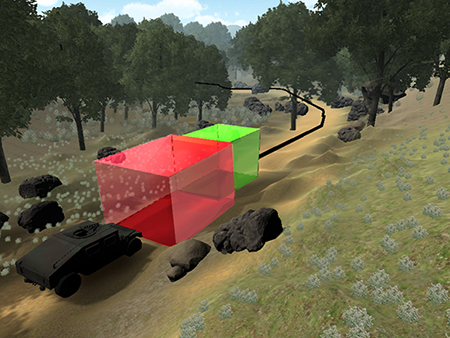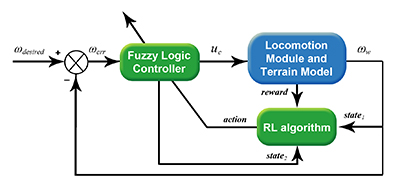Media contact: Yvonne Taunton
 UAB will build an autonomous vehicle mobility facility that works in collaboration with its Engineering and Innovative Technology Development research group.The University of Alabama at Birmingham School of Engineering recently launched a new research initiative that could help shape the future of autonomous vehicles. Funding for the project includes $35 million over four years from the United States Department of Defense and the U.S. Army Combat Capabilities Development Command Ground Vehicle Systems Center.
UAB will build an autonomous vehicle mobility facility that works in collaboration with its Engineering and Innovative Technology Development research group.The University of Alabama at Birmingham School of Engineering recently launched a new research initiative that could help shape the future of autonomous vehicles. Funding for the project includes $35 million over four years from the United States Department of Defense and the U.S. Army Combat Capabilities Development Command Ground Vehicle Systems Center.
UAB will build an autonomous vehicle mobility facility that works in collaboration with its Engineering and Innovative Technology Development research group, the CCDC GVSC, multiple organizations within NATO, partner universities in the Automotive Research Center, and industry.
“This research facility will serve as the first academic national-level laboratory of the U.S. Army CCDC GVSC dedicated to autonomous mobility research and engineering,” said Vladimir Vantsevich, professor of mechanical engineering and director of the UAB Vehicle and Robotics Engineering Laboratory. “UAB will become a hub for international academic and professional education by developing and delivering training programs that will provide enhanced expertise in the U.S. and other NATO nations.”
In addition to Vantsevich, the institute will be co-directed by Lee Moradi, Ph.D. Moradi is currently director of the EITD, which has extensive experience working with government agencies through its work with NASA building hardware for the International Space Station.
“Dr. Vantsevich is an internationally recognized leader in the field of autonomous vehicles who will lead a dynamic program ranging from soil mechanics to tire dynamics and control, to novel sensing and AI-based control technologies,” said Jeff Holmes, M.D., Ph.D., dean of the UAB School of Engineering. “This partnership with the U.S. Army GVSC, together with Dr. Moradi’s work with NASA and other partnerships with the Department of Defense, really cements UAB’s status as a hub for innovative defense and space research. I am particularly excited about the training opportunities these projects offer students interested in defense-related engineering careers.”
The goal of this effort is to contribute to the development of a new generation of combat vehicles and to assume a leading role in academic education and research among NATO nations. Advanced technology in this area, Vantsevich says, will include:
- Different levels of autonomy of unmanned ground systems
- Autonomous vehicles and vehicle autonomous sub-system design for integrated intelligent mobility
- Effective development and application of artificial intelligence and common control of the unmanned ground and aircraft systems
- Training warfighters in the gaming military settings based on realistic interactions between autonomous vehicle and environment, artificial and human intelligence
The key research component that will be built at UAB is a new research facility called Simulator of Autonomous Mobility. SAM will be a first-of-its-kind cyber-physical indoor proving ground for applications of artificial intelligence to vehicle design for autonomous mobility.
“Even though SAM is funded by the Department of Defense, the facility is expected to advance vehicle technology transformation beyond the military sector,” Vantsevich said. “Considering the geographic proximity of UAB to automotive original equipment manufacturers including the National Soil Dynamics Laboratory in Auburn, Alabama, the Oak Ridge National Laboratory in Oak Ridge, Tennessee, and Redstone Arsenal in Huntsville, SAM can be expected to stimulate vehicle technology advances in both the military and civilian sectors.”
 This convergence is expected to positively impact the automotive engineering and manufacturing companies and research companies in Alabama and throughout the Southeast.
This convergence is expected to positively impact the automotive engineering and manufacturing companies and research companies in Alabama and throughout the Southeast.
“Truck engineering and trucking companies, construction equipment and farm tractor engineering in the United States desperately need such test facilities, which do not exist anywhere in the world,” Vantsevich said.
From an academic perspective, this effort aims to further UAB’s educational initiatives and become a hub for international academic and professional education by developing a new Master of Science degree in high mobility vehicle engineering.
The master’s program is expected to provide enhanced expertise in the United States and other NATO nations, including NATO nations in Eastern Europe and Ukraine. The new academic program will systematically develop a curriculum and teach advanced courses on autonomous vehicle mobility in various environments.
With that in mind, the master’s program is designed to eliminate the gap between military vehicle research/engineering and university education and to facilitate future engineering of military and off-road vehicles in the United States and other NATO nations.